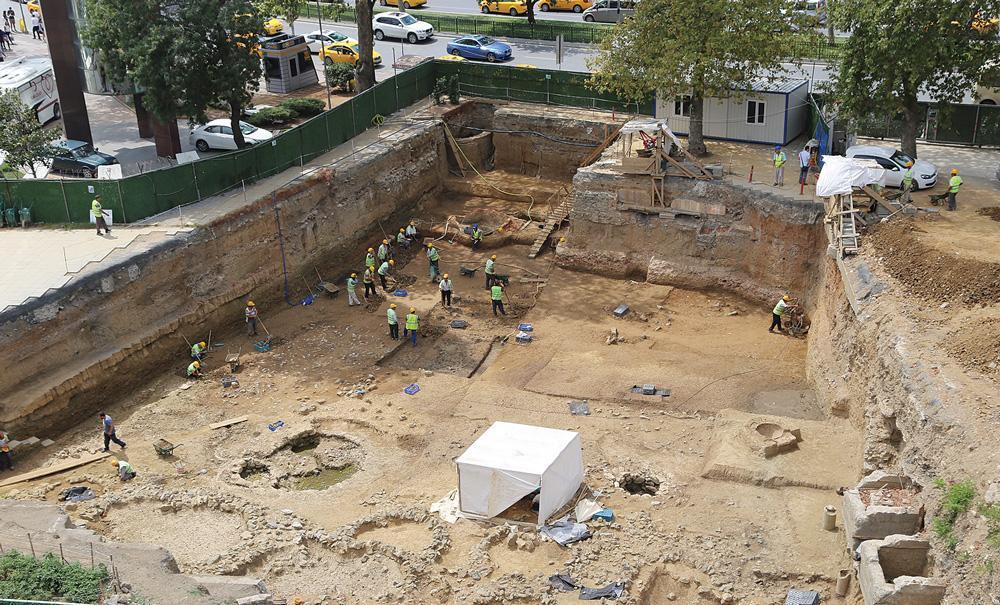Best archaeological discoveries in 2017
ÖMER ERBİL

The graves in Beşiktaş
In 2017, 3,500-year-old graves were unearthed during subway construction works in Istanbul’s Beşiktaş neighborhood, shedding light on the history of both Anatolia and Turkey.
Then there was The Urartian Castle, which was monitored using underwater cameras, and the tomb of a Russian commander, which was found accidentally at a construction site in the southeastern province of Ardahan. These were among the most talked about archaeological discoveries last year.
Here is a list of top nine archaeological discoveries in Turkey in 2017.
Beşiktaş graves
Subway excavations on the site of a 3,500-year-old graveyard in the Beşiktaş neighborhood of Istanbul unearthed 35 graves. The discovery of cairn burials that pertain to the Northern Black Sea steppe culture – namely earlier Turkish and Altai cultures – was an exciting surprise for the scientific world.
Although archaeologists stress how hard it is to determine the ethnicity of the people who made these burials, scientific sources suggest that Turks maintained their own cairn burial methods until the 10th century. The result of the anthropologists’ analysis of the skeletons found in the graves should reveal the origins of Istanbul’s oldest residents.
The Urartian Castle
Underwater photographer and videographer Tahsin Ceylan and Van Yüzüncü Yıl University Fishery Faculty academic Mustafa Akkuş discovered a 3,000 year-old castle in Lake Van, Turkey’s biggest lake in the eastern province of Van.
The find was made as the pair sought to reveal the secrets of the lake. A three- to four-meter wall section is observable and the castle ruins cover an area of one kilometer. Underwater archaeologists will soon make studies on the castle to find out more.
3. Grave of Russian commander
The body of a 19th-century Russian military officer was found inside an unearthed coffin in the eastern province of Ardahan. The coffin was initially believed to have belonged to Russian general Vasiliy Geyman but he was identified as Lt. Col. Karl Karlovich Rjepetsky, who was a member of the 78th Navaginsky regiment of the 20th infantry division of the 1st Caucasian Army Corps. Rjepetsky’s remains were subsequently put under protection at the Kars Museum.
Sultan’s bath in Topkapı Palace
A Turkish bath used by five Ottoman Sultans was uncovered during restoration work at Topkapı Palace – the first and most famous of the sultans’ residences and administrative centers in Istanbul. The bath, which has only been mentioned in written documents before, came to light by chance during the restoration of the Dormitory of the Expeditionary Force (Seferli Koğuşu).
Although a couple of books refer to this hamam, it was documented for the first time during restoration works, the Topkapı Palace Museum head Prof. Dr. Mustafa Küçükaşçı said.
Ancient city in Kayseri
Archaeological excavations around the central Anatolian city of Kayseri unearthed 12 Bronze-age tablets, featuring the traces of the ancient cities that were established thousands of years ago. The name of the ancient city of Sinahuttum is mentioned 14 times in the tablets of the Syriac traders. According to researchers, this city is in the northeast of Hattusha, today’s Çorum’s Boğazkale district. The locations of Purushattum, Mamma, Zalpa and Hahhum were also found using the same method.
Sculpture in Tayinat Mound
Excavations at the Tayinat Mound in the southern Turkish province of Hatay uncovered an ancient sculpture of a woman, around the same size as the statue of King Suppiluliuma previously discovered at the site. It is thought that the sculpture, which has some broken parts, represents the wife of the King Suppiluliuma.
The sculpture, which consists of a head and body, is thought to date back to the late Hittite period in the 9th century B.C. Works have been continuing at the mound with a team of 20 people, under the leadership of Professor Timothy Harrison of Toronto University.
Gymnasium in Konya
A Roman-era sports facility gymnasium has been unearthed at a construction site in the Sarayönü district of the Central Anatolian province of Konya. The finding emerged after a local in the district’s Ladik neighborhood, once a Laodicea city and an important center in the Roman era, notified the local museum directorate after initially wanting to build a house on the land where the facility was unearthed. The area was classed as a third-degree archaeological site with many artifacts.
Human bones in Göbeklitepe
Researchers have found thousands of human and animal bones in the 12,000-year-old ancient settlement of Göbeklitepe in Turkey’s southeastern province of Şanlıurfa, known as the “zero point of history.” Among tens of thousands of bones, researchers uncovered the remains of human skulls that were stripped of their flesh and carved with deep, straight grooves running front to back. The carvings represent the first evidence of skull decoration in the archaeological record of the region.
Ancient prenuptial agreement
A 4,000 year-old prenuptial agreement, which was found in the central Anatolian province of Kayseri and dates back to the Assyrians, revealed history’s first infertility diagnosis. According to the agreement, if no fertility occurs after two years of marriage, the wife must allow her husband to have children with a female slave. After the first son is born, the slave is set free.
















